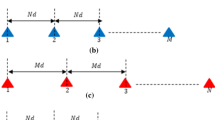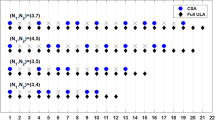Abstract
In this paper A different approach based on the reconstruction of the data covariance matrix is presented. In the presented approach, by vectorization of the reconstructed matrix, the covariance matrix is reconstructed in two steps. Hence an extensive network of virtual sensors is created, which is introduced as a second-order difference co-array. Then, by using the well-known spatial smoothing technique full-rank covariance matrix is obtained for DOA estimation algorithms. Therefore the MN sources can be detected using a physical array with M + N sensors. The degrees of freedom (DOF) of the second-order difference co-array are significantly increased as opposed to the physical array which provides only N − 1 degrees of freedom. As a result, for a certain number of array elements, in addition to the resolution improvement, the number of detectable targets is sharply increased. Simulation results verify the effectiveness of the proposed method and MUSIC-based or ESPRIT-based DOA estimators could be designed to perform DOA estimation.























Similar content being viewed by others
Data availability
Not applicable.
Code availability
Not applicable.
References
H. L. V. 2002 Trees, Detection, Estimation, and Modulation Theory. Part IV., Optimum Array Processing, Wiley- Interscience.
T. E. Tuncer and B. Friedlander, Classical and Modern Direction-of-Arrival Estimation, Academic Press, 2009.
Bienvenu, G., & Kopp, L. (1983). Optimality of high resolution array processing using the eigensystem approach. IEEE Transactions on Acoustics, Speech, and Signal Processing, 31(5), 1235–1247.
Brillinger, D. R. (1985). A maximum likelihood approach to frequency wavenumber analysis. IEEE Transactions on Acoustics, Speech, and Signal Processing, 33(4), 1076–1085.
Kumaresan, R., & Tufts, D. W. (1983). Estimating the angles of arrival of multiple plane waves. IEEE Transactions on Aerospace and Electronic Systems, 19(1), 134–138.
Roy, R., Paulraj, A., & Kailath, T. (1986). ESPRIT—A subspace rotation approach to estimation of parameters of cisoids in noise. IEEE Transactions on Acoustics, Speech, and Signal Processing, 34(5), 1340–1342.
Schmidt, R. O. (1986). Multiple emitter location and signal parameter estimation. IEEE Transactions on Antennas and Propagation, 34(3), 276–280.
Viberg, M., & Ottersten, B. (1991). Sensor array processing based on subspace fitting. IEEE Transactions on Acoustics, Speech, and Signal Processing, 39(5), 1110–1121.
Burg, J. P. (1972). The relationship between maximum entropy spectra and maximum likelihood spectra. Geophys, 37(2), 375–376.
Capon, J. (1969). High resolution frequency-wavenumber spectrum analysis. Proceedings of the IEEE, 57, 1408–1418.
Kaveh, M., & Barabell, A. J. (1986). The statistical performance of the MUSIC and the minimum norm algorithms in resolving plane waves in noise. IEEE Transactions on Acoustics, Speech, and Signal Processing, 34(2), 331–341.
Stoica, P., & Nehorai, A. (1989). MUSIC, maximum likelihood and Cramer Rao bound. IEEE Transactions on Acoustics, Speech, and Signal Processing, 37(12), 720–741.
Stoica, P., & Nehorai, A. (1990). MUSIC, maximum likelihood, and Cramer-Rao bound: Further results and comparisons. IEEE Transactions on Acoustics, Speech, and Signal Processing, 38(12), 2140–2150.
Dogan, M. C., & Mendel, J. M. (1995). Applications of cumulants to array processing - Part I: Aperture extension and array calibration. IEEE Transactions on Signal Processing, 43(5), 1200–1216.
Chevalier, P., Albera, L., Ferreol, A., & Comon, P. (2005). On the virtual array concept for higher order array processing. IEEE Transactions on Signal Processing, 53(4), 1254–1271.
Chevalier, P., & Ferreol, A. (1999). On the virtual array concept for the fourth-order direction finding problem. IEEE Transactions on Signal Processing, 47(9), 2592–2595.
Cardoso, J.-F. (1990). Localisation et identification par la quadricovariance. Traitement du Signal, 7(5), 397–406.
Chiang, H. H., & Nikias, C. L. (1989). The ESPRIT algorithm with high order statistics (pp. 163–168). Proc. Workshop Higher Order Statistics.
Gönen, E., & Mendel, J. M. (1999). Applications of cumulants to array processing— Part VI: Polarization and direction of arrival estimation with minimally constrained arrays. IEEE Transactions on Signal Processing, 47(9), 2589–2592.
Porat, B., & Friedlander, B. (1991). Direction finding algorithms based on higher order statistics. IEEE Transactions on Signal Processing, 39(9), 2016–2024.
Shamsunder, S., & Giannakis, G. B. (1993). Modeling of non-Gaussian array data using cumulants: DOA estimation of more sources with less sensors. Signal Processing, 30(3), 279–297.
Chevalier, P., Ferréol, A., & Albera, L. (2006). High-resolution direction finding from Higher order statistics: The 2q-MUSIC algorithm. IEEE Transactions on Signal Processing, 54(8), 2986–2997.
Pal, P., & Vaidyanathan, P. P. (2012). Multiple level nested array: An efficient geometry for 2qth order cumulant based array processing. IEEE Transactions on Signal Processing, 60(3), 1253–1269.
Hoctor, R. T., & Kassam, S. A. (1990). The unifying role of the coarray in aperture synthesis for coherent and incoherent imaging. Proceedings of the IEEE, 78(4), 735–752.
Moffet, A. (1968). Minimum-redundancy linear arrays. IEEE Transactions on Antennas and Propagation, 16(2), 172–175.
Bloom, G. S., & Golomb, S. W. (1977). Application of numbered undirected graphs. Proceedings of the IEEE, 65(4), 562–570.
Pal, P., & Vaidyanathan, P. P. (2010). Nested arrays: A novel approach to array processing with enhanced degrees of freedom. IEEE Transactions on Signal Processing, 58(8), 4167–4181.
Gupta, I. J., & Ksienski, A. A. (1983). Effect of mutual coupling on the performance of adaptive arrays. IEEE Transactions on Antennas and Propagation, AP-31(5), 785–791.
Zhang, Y., Hirasawa, K., & Fujimoto, K. (1987). Signal bandwidth consideration of mutual coupling effects on adaptive array performance. IEEE Transactions on Antennas and Propagation, AP-35(3), 337–339.
Chen, T., Shi, L., & Guo, L. (2019). Sparse DOA estimation algorithm based on fourth-order cumulants vector exploiting restricted non-uniform linear array. IEEE Access, 7, 9980–9988.
Zhou, Y., Li, J., Nie, W., & Li, Y. (2021). The fourth-order difference co-array construction by expanding and shift nested array: Revisited and improved. Signal Processing, 188, 108198.
Vaidyanathan, P. P., & Pal, P. (2011). Sparse sensing with co-prime samplers and arrays. IEEE Transactions on Signal Processing, 59(2), 573–586.
Qin, S., Zhang, Y. D., & Amin, M. G. (2015). Generalized Coprime Array Configurations for Direction-of-Arrival Estimation. IEEE Transactions on Signal Processing, 63(6), 1377–1390.
Tan, Z., Eldar, Y. C., & Nehorai, A. (2014). Direction of arrival estimation using Co-prime arrays: A super-resolution viewpoint. IEEE Transactions on Signal Processing, 62(21), 5565–5576.
Liu, K., & Zhang, Y. D. (2018). Coprime array-based DOA estimation in unknown nonuniform noise environment. Digital Signal Processing, 76, 66–74.
B. Liao, C. Guo, L. Huang, J. Wen, (2016) Matrix completion based direction-of-arrival estimation in nonuniform noise. In: Proceedings of 2016 IEEE International Conference on Digital Signal Processing (DSP), Beijing, China, pp. 66–69.
Qin, Si., Zhang, Y. D., Amin, M. G., & Himed, B. (2017). DOA estimation exploiting a uniform linear array with multiple co-prime frequencies. Signal Processing, 130, 37–46.
Mei, F., Xu, H., Cui, W., Ba, B., & Wang, Y. (2021). A transformed coprime array With reduced mutual coupling for DOA estimation of non-circular signals. IEEE Access, 9, 125984–125998.
Lu, A., Guo, Y., Li, N., & Yang, S. (2020). Efficient gridless 2-D direction-of-arrival estimation for coprime array based on decoupled atomic norm minimization. IEEE Access, 8, 57786–57795.
Chen, Z., Fan, C., & Huang, X. (2020). Interpolation-based direction-of-arrival estimation for coprime arrays via covariance matrix fitting. IEEE Access, 8, 149133–149141.
Funding
Not applicable.
Author information
Authors and Affiliations
Corresponding author
Ethics declarations
Conflicts of interest
Not applicable.
Additional information
Publisher's Note
Springer Nature remains neutral with regard to jurisdictional claims in published maps and institutional affiliations.
Rights and permissions
Springer Nature or its licensor holds exclusive rights to this article under a publishing agreement with the author(s) or other rightsholder(s); author self-archiving of the accepted manuscript version of this article is solely governed by the terms of such publishing agreement and applicable law.
About this article
Cite this article
Sharifzadeh Lari, A., Abbasi-Moghadam, D. DOA Estimation Based on Second-Order Difference Co-Array for Coprime Arrays. Wireless Pers Commun 126, 3167–3194 (2022). https://doi.org/10.1007/s11277-022-09858-w
Accepted:
Published:
Issue Date:
DOI: https://doi.org/10.1007/s11277-022-09858-w




